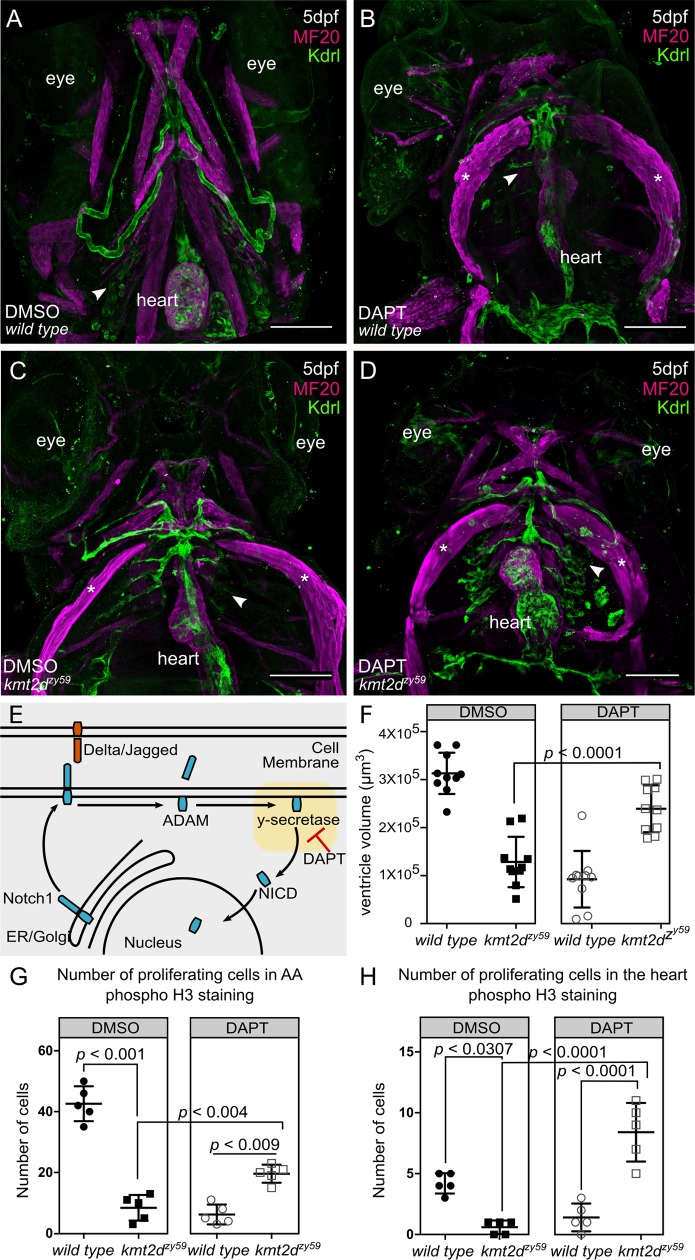Fig 7. Inhibition of Notch pathway with DAPT rescues cardiovascular phenotypes in kmt2d mutants by enhancing cell proliferation in endothelial and endocardial cells.
(A-D) Confocal images of wild-type sibling (A, B) and kmt2dzy59 mutant (C, D) embryos at 5 dpf. DMSO as solvent control (A, C) and DAPT for Notch signaling inhibition (B, D) were applied to embryos of indicated genotypes. DAPT treatment affected cardiovascular development in wild-type embryos (B) as a consequence of Notch signaling inhibition. kmt2dzy59 mutants that were treated with DAPT had rescued AA development and partially rescued heart development (D) when compared with the kmt2dzy59 DMSO control group (C). Arrowheads indicate normal (A), disrupted (B, C), and rescued (D) AA. Note that cardiovascular phenotype was rescued in DAPT-treated mutants despite cardiac edema, as evidenced by the sternohyoideus deformation (asterisk; B, C, D, MF20 in magenta). (E) Schematic of Notch signaling pathway showing DAPT inhibition of γ-secretase activity, the second cleavage step of Notch receptor processing. DAPT thus prevents NICD release to the cytoplasm for nuclear import. (F) Cardiac ventricle volume measurements for DMSO control groups (wild type and kmt2dzy59) and DAPT treatment groups (wild type and kmt2dzy59). The volume of the ventricle chamber was significantly rescued in kmt2dzy59 mutant embryos after Notch pathway inhibition with DAPT. Embryos were randomly selected from 3 different clutches; measurements were blind to embryo genotypes, which were assayed by HRMA after measurement. Two-way ANOVA multiple comparison test adjusted p-values per each condition as follow: wild-type DMSO versus wild-type DAPT, p < 0.0001; wild-type DMSO versus kmt2dzy59 DMSO, p < 0.0001; wild-type DMSO versus kmt2dzy59 DAPT, p = 0.0159; wild-type DAPT versus kmt2dzy59 DMSO, p = 0.5482; wild-type DAPT versus kmt2dzy59 DAPT, p < 0.0001; kmt2dzy59 DMSO versus kmt2dzy59 DAPT, p = 0.0001. Values for each data point can be found in S1 Data. (G) Number of endothelial cells proliferating in the AA region in each group treatment. There were significantly more proliferating endothelial cells in the AA region of kmt2dzy59 mutant after DAPT treatment, indicating that the phenotype was rescued by increasing cell proliferation. Two-way ANOVA multiple comparison test adjusted p-values per each condition as follow: wild-type DMSO versus wild-type DAPT, p = 0.0001; wild-type DMSO versus kmt2dzy59 DMSO, p = 0.0001; wild-type DMSO versus kmt2dzy59 DAPT, p = 0.0006; wild-type DAPT versus kmt2dzy59 DMSO, p = 0.6043; wild-type DAPT versus kmt2dzy59 DAPT, p = 0.0091; kmt2dzy59 DMSO versus kmt2dzy59 DAPT, p = 0.0047. Values for each data point can be found in S1 Data. (H) Number of endocardial cells proliferating in the heart per experimental group. There were significantly more proliferating endocardial cells in kmt2dzy59 mutant hearts after DAPT treatment, indicating that the phenotype was rescued by increasing endocardial cell proliferation. Two-way ANOVA multiple comparison test adjusted p-values per each condition as follow: wild-type DMSO versus wild-type DAPT, p = 0.0051; wild-type DMSO versus kmt2dzy59 DMSO, p = 0.0307; wild-type DMSO versus kmt2dzy59 DAPT, p = 0.0013; wild-type DAPT versus kmt2dzy59 DMSO, p = 0.8106; wild-type DAPT versus kmt2dzy59 DAPT, p < 0.0001; kmt2dzy59 DMSO versus kmt2dzy59 DAPT, p < 0.0001. Cell count was blind and embryos were randomly selected from 2 different clutches (E, F). Genotype was confirmed after measurement by HRMA. Values for each data point can be found in S1 Data. AA, aortal arch; ADAM, containing a disintegrin and metalloprotease; dpf, days post fertilization; ER, endoplasmic reticulum; HRMA, High Resolution Melt Analysis; kdrl, kinase insert domain receptor like; MF20, Myosin Heavy Chain Antibody; NICD, Notch intracellular domain.

